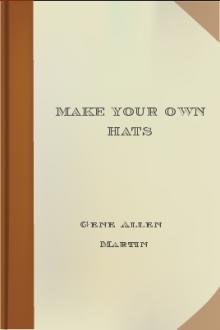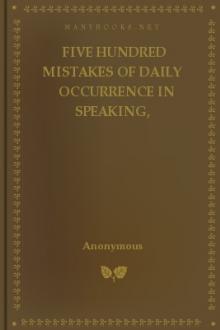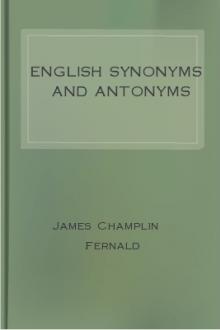Make Your Own Hats, Gene Allen Martin [ebook offline txt] 📗

- Author: Gene Allen Martin
- Performer: -
Book online «Make Your Own Hats, Gene Allen Martin [ebook offline txt] 📗». Author Gene Allen Martin
A round crown is one which rounds from tip to base. First straighten, measure, and cut four sticks of brace wire, as for square crown, of the ordinary length, allowing for finishing. Cut and join the ends of a short piece of brace wire five or six inches long. This makes a small circle for the top of the crown. Begin by tying the sticks across this circle under it, dividing it into halves, quarters, and eighths, being careful that the divisions are made accurately and that the sticks extend an equal length from the circle. Keep these wires flat across this circle. The sticks may now be curved down. It is sometimes found easier to attach the base wire at this point before adding other circles.
Base wire—
Cut a piece of brace wire one-half inch longer than the wire used for the headsize wire. Lap the ends one inch. Make this the same shape as the headsize wire and test the size by trying it on over the headsize wire on the brim for which the crown is made. An ordinary height for a round crown would be seven inches from tip to base wire, but to be safe, it is always better to measure the head. Sometimes, on account of an abundance of hair or a high coiffure, a greater height is needed. If the base wire is elongated to fit the head, the side measurement from the tip to the base of the crown will be found shorter than from the tip to the front and the back. It will be most helpful to take an old crown which has an elongated headsize and either measure it and work from the measures or else work over it.
The crown must be even at the bottom when finished, and when placed upon the table must rest evenly. The base wire may be tied with tie wire on the front and back spokes and on each side spoke until the circles between it and the crown tip are added. It will then be found easy to adjust it before finishing off the wires; i.e., the crown may be made higher or lower.
Circles or hoops—
Add three circles of wire between the base wire and the small circle at the top. The first circle just above the base wire should be of the same size. Keep all wire laps at the back. The other two circles will conform to the shape of the crown and will be found to be a little further apart at the front and back than at the sides.
To finish the base of the crown—
The spokes of the crown may now be turned out sharply where the base wire is to be fastened and finished off the same as the edge wire on the brim.
A shaped wire frame made in one piece—
The simplest wire frame which is shaped at all is the mushroom shape or one that droops a little. Before beginning this hat it will be found easier to have a pattern for the brim, but it will not be necessary to make a pattern for the crown, which may be either round or square, and for which directions have already been given.
Pattern for brim—
Make a pattern of manila paper for the brim the same as for a fabric shape, following the same directions. It may droop only a very little or fit quite close. In either case the method is the same.
Pin the headsize wire on this pattern and try on to shape. Mark on the wire at the point where the creases touch the wire. It is important not to hurry at this point. Make many patterns and then choose the most becoming one. After the pattern is perfected, crease it sharply the same as in the sailor brim. Take all the measurements from this pattern and use them in marking the wires. This brim pattern is not needed until the crown has been made. In making a wire frame in one piece, we begin at the top of the crown and work down.
Crown—
Measure four sticks as for the crown in the preceding lesson, plus the width of the brim, plus six inches for finishing. This is ample to finish both ends of wire, but on account of the ends easily becoming frayed it is better to have a generous allowance. Begin at the crown tip and work down until ready for the headsize wire. The last wire is or should be of the same size as the regular headsize wire. Place the lap of the headsize wire on the back spoke of the crown and join by twisting the spokes once and a half around. Join the front and remaining spokes in the same way, being careful to join where the wire was marked at the creases on the pattern.
Brim—
We are now ready to make use of the measurements taken from the pattern. Mark the length of each spoke with a pencil; the distance they are to be apart should be marked on the edge wire. These measurements are taken from the pattern. Finish the edge the same as the sailor brim. Add as many circles between the edge wire and the headsize wire as desired.
We have now made in wire the first variation from a perfectly flat brim. Always make a pattern before making a wire frame except when copying and then measurements may be taken from the hat to be copied. Here are some of the reasons why the pattern is important: first, it may be tried on and this helps to decide if the style is becoming, before working it out in wire; second, the position of the wires may be determined and marked on the paper pattern; third, the more work done from a paper pattern the easier it will be to copy; fourth, it trains the eye, thus making free-hand work much easier.
A rolling brim—
Whether the hat is made in one piece or with a separate brim, the same method is used. First, as always, the paper pattern. If the brim is to roll closely on one side and much higher than on the other, extra wires will be needed to fill the space. The place for these may be determined on the paper pattern. They may go all the way around, being brought more closely together on the low side or only part way around as in the illustration.
Wire frame making requires much patience and practice. It is an art just as all millinery is an art. Lines are all important. Because of this I urge much pattern making. Even though one may not have the fundamental principles of art, something really good often develops and we find we have built better than we knew. It stimulates originality, but we must work without fear.
To color wire frames—
Wires come in both black and white. A white frame may be colored to match any sheer fabric used for its covering. It will be found to be more simple to color the frame after it is made. Any of the cold or soap dyes may be used. If these are not available, a piece of velveteen soaked in alcohol and rubbed on the frame will give of its color sufficiently to tint the wire. Crêpe paper may also be used, or water-color paints. Rouge may be used effectively if moistened. There are also gold and silver wires which may be used for frames when desired, and which will add to the beauty of the design. If they cannot be purchased, a frame of white wire may be gilded by using liquid gilt, applying it to the frame with a small brush.
Halo hat brims—
Halo brims may be made from any fabric, but to be effective the material should be sheer. Malines, nets, georgette crêpe, or chiffon are all used to good effect in making this style of hat. Good-looking halo brims have been made from old georgette waists, using the back for the brim and the front and sleeves for the crown.
Only two wires are used in making this brim, the edge wire and the headsize wire. The size of the brim is to be determined and then a hoop of sprung wire cut just the length of the circumference of the brim. This wire is uncovered; the ends just meet and are joined by the use of a little clamp, the ends being inserted and pressed down with the jaws of the pliers.
Place the material from which the brim is to be made upon a flat surface. If of maline, several thicknesses may be used. Fasten this material down to the table slightly with pins or thumb tacks. Lay a circle of sprung wire on the material and pin in place. Begin by pinning the back, front, and then each side, being careful not to pull the wire out of shape. Take the work up and pin the material closely all around the edge. Cut off, allowing one-quarter of an inch to turn over the wire. Sew to the wire closely with an overcasting stitch or with a running stitch just inside of the wire. The edge may be bound with a fold of the same material, a fold of satin or one row of braid.
Headsize wire for halo brim—
This headsize wire is made of frame wire. First measure, then cut, join ends, and shape as for any hat. Lay the headsize wire on the material, having the joining at the back. The front and the back of the brim, if of equal width, will be somewhat narrower than the side because of the elongated headsize wire; however, the headsize wire may be placed on the brim in any position desired. Pin in place and sew with an overcasting stitch. Trim the material inside the headsize wire, leaving an extension of one-quarter of an inch to turn over; it will be found necessary to sew this down over the wire, making the edge more secure.
Another method of making a halo brim is accomplished by cutting a piece of material on the bias, twice as wide as the brim and as long as the circumference. Stretch this piece of material, then pin the center of the strip over the edge wire, gather the raw edges to fit the headsize wire and sew in place. This method does not make a smooth brim, but is more quickly made. When two thicknesses of sheer material are used for halo brims a very pretty effect is obtained by placing flat flowers, petals of flowers, or feathers between the two materials.
Crown for halo brim—
This may be very sheer, although a halo brim may be used on a braid or satin crown if desired. A wire crown for a halo brim usually consists of a mere collar of frame wire several inches high. This is sewed to the headsize wire. The covering for the crown is usually made in the shape of a circle about fourteen inches in diameter, with the same number of thicknesses as the





Comments (0)